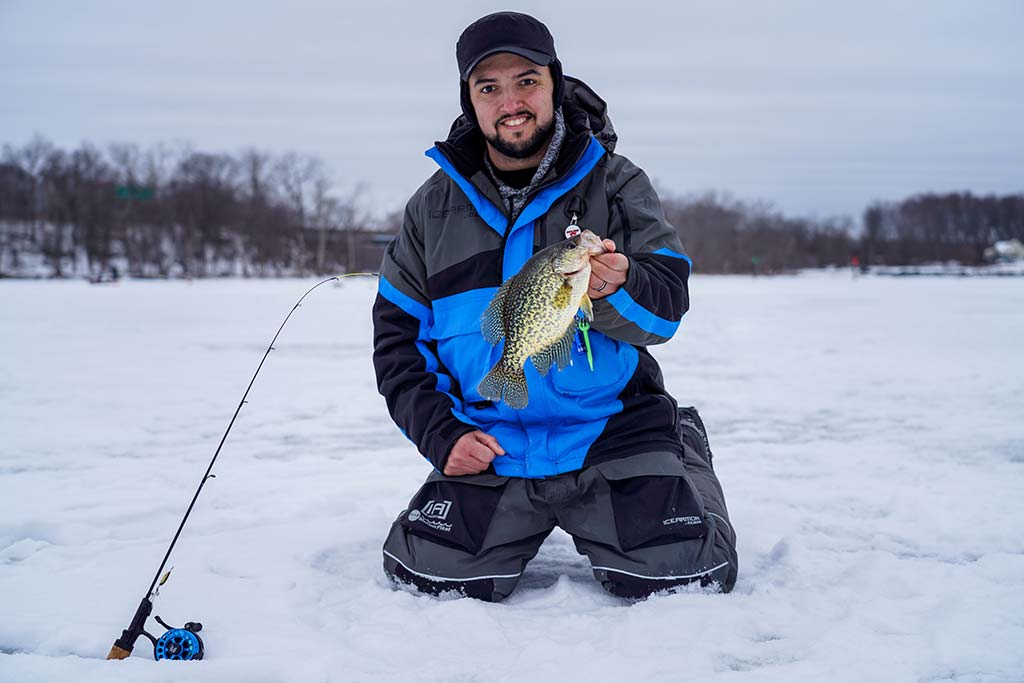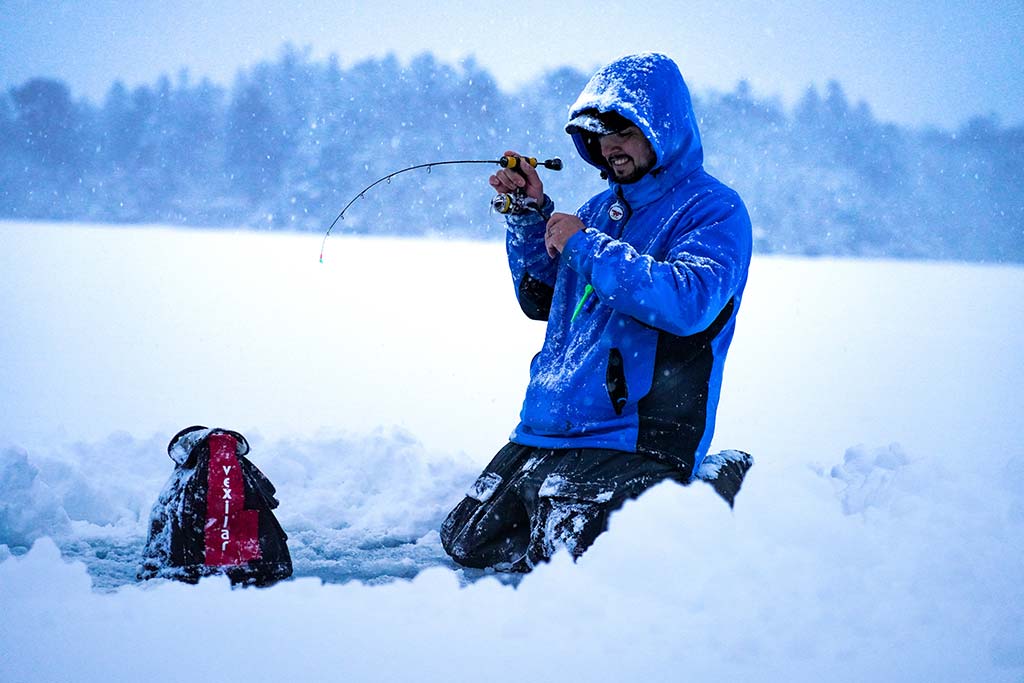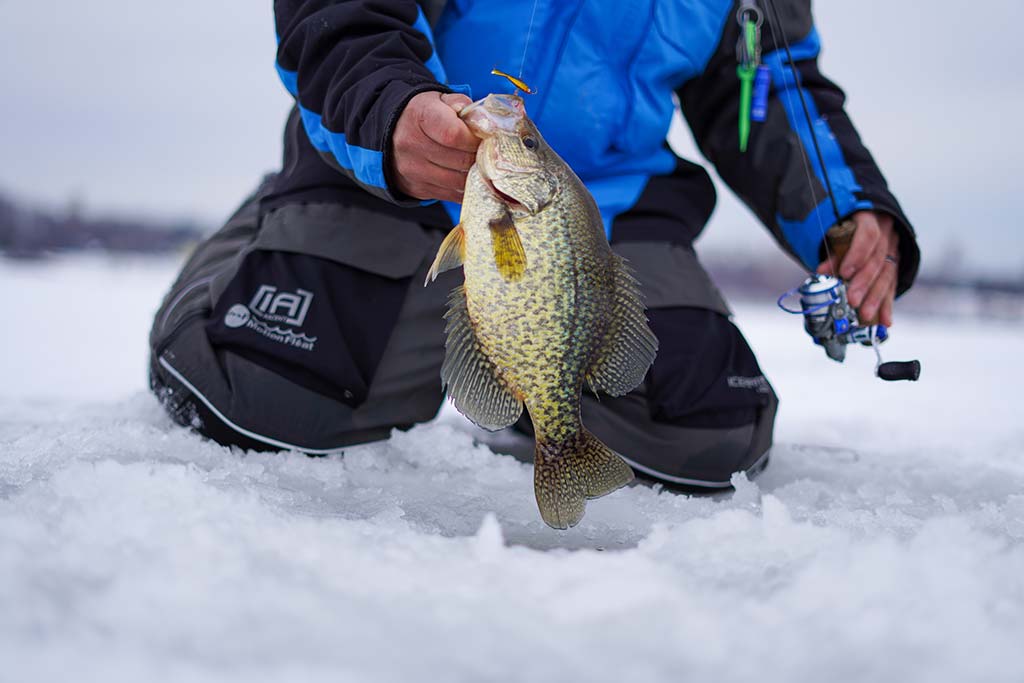
Finesse is not always the key to hardwater success!
When most anglers think of ice fishing they think of cold water temperatures and inactive fish. The word “finesse” gets thrown around a lot in the world of ice fishing, and while on some days that approach that might be best, it is not always the case. Large minnow-style jigs and spoons darting erratically through the water column can sometimes trigger even the finickiest fish to bite.
Hardwater panfish can sometimes drive anglers crazy as they watch a fish on their flasher just staring at their presentation, unwilling to fully commit. Most angler’s reaction to this is to slow down or even stop. In most cases that is actually the worst thing you can do. You are trying to mimic a type of forage with your presentation and as a fish closes in on its prey, the forage would naturally become nervous and try to escape. By slowing down your presentation or stopping altogether, you are creating an unnatural presentation and causing an alarm to go off in the fish’s head that something might not be right. Instead, by keeping that bait moving through the water column aggressively, oftentimes the fish’s reaction is to be aggressive as well.
Be Aggressive
Fishing more aggressively can help anglers put more fish on the ice this winter. While we are very excited to see the growing popularity of the sport of ice fishing, the spike in the number of anglers on the ice has caused a lot of pressure on many bodies of water. Fish are becoming smarter and warier because of this increased fishing pressure. All too often I will hit a popular fishing hole with many other anglers and they will say things like, “the fish are turned off and won’t bite.” When I find myself in these situations I try to change up my presentation and show the fish something they haven’t seen. This could be a bait, a color, or even the action you give a lure. These nontraditional methods often get fish triggered and get them to bite.
Being aggressive can do a lot of different things for an angler. Aggressively jigging can help you cover more of the water column quicker. When you are fishing slower and with subtler motions you are limited to a small section of the water column and could be missing fish that may be suspended or not right on the bottom. Fishing aggressively can also help you cover more area. You won’t spend as much time fishing each hole as you rapidly hole-hop to locate fish. Another benefit to fishing aggressively is that often your aggressive approach will cause the biggest fish in the school to bite first. You can quickly pick up a few bigger fish out of a school and then move on when you begin catching smaller fish.

Bigger Can Be Better
I utilize three different presentations when fishing aggressively for panfish through the ice. The first method is using larger jigs with soft plastics. Using a larger jig will allow you to get down to the strike zone faster and stay on fish longer. Using a soft plastic as opposed to live bait gives the jig a larger profile as it goes through the water column. Fish can see that larger profile much easier from farther away and will move in to investigate. A soft plastic is more durable than live bait eliminating the need to stop and rebait your hook after each fish. That soft plastic will kick and flutter as you jig your lure, triggering fish to attack.
I like to start off with the biggest jig and plastic combination that I feel comfortable with. This allows me to weed out some of the smaller fish that may “peck” at the jig. As the day goes on I can downsize until I find the perfect size for that specific day. I don’t like to start small and gradually get bigger because I often find myself wasting too much time weeding through those smaller fish early in the day and missing out on the opportunity to catch some bigger fish.
Spoon Feeding
The second method I use is fishing with larger spoons. I use spoons varying in sizes from 1/16- to a half-ounce when ice fishing. A 1/16-ounce spoon is almost always tied on one of my rods when chasing panfish. When fishing over basin fish, jigging larger spoons aggressively will help draw fish to you from farther away. Oftentimes I will drop my spoon down and not see any fish on my flasher. After some aggressive rips of the spoon, fish will begin to show up to investigate my presentation.
This method is also useful in shallow water and when fishing structure. Often, I find that fishing these bigger spoons just over brush or rock piles will draw the larger fish out of the structure to see what’s going on. Many times, I find myself weeding through short fish when ice fishing looking for a bigger bite, using these big spoons can help weed out some of those smaller fish and entice the biggest fish in the school to hit.
Jigging Minnows
Jigs and spoons are a staple of many ice fishing tackle boxes but jigging minnows are becoming more and more popular. These horizontal swim baits mimic an injured minnow and have put many fish on the ice over the years. These baits are very unique in that when they are dropped through the water, they glide and flutter off to the side of the hole. Typically, an angler is limited to what is directly under their hole but with these minnow style jigs, the lure scopes out to either side of the hole and covers much more water. These baits are meant to be fished aggressively. Hard rips followed by a brief settling of the lure drive panfish crazy and has them looking to strike violently.
As you jig these minnows, the lure comes back to the center. When you pause, that is when the lure scopes out and flutters. You know you are fishing it correctly when it disappears off the screen of your electronics and then comes back as you jig it. When you have a fish following this presentation it is time to change your jigging cadence though. It is important to continue snapping the jig before it settles to keep the lure darting in the same direction when you are being chased. When you let it rest too long, you have no control over the direction that it will flutter. This may cause the lure to flutter unexpectedly behind the chasing fish causing an unnatural presentation and the fish to shy away in most cases. When a fish is following your lure, it is important for your action to become predictable so that the fish can hone in on it and attack. The erratic action of these style baits and the aggressive nature of the ripping action that anglers use when fishing them causes fish to become more active and turn on an otherwise slow bite.

Rigged & Ready
While fishing aggressively for panfish, a proper rod is necessary to get the desired action. I like to use a solid graphite rod with a firm backbone. You typically don’t want a spring bobber or slower rod tip with these presentations as it will slow down your jigging cadence and not get the desired “snap” anglers are looking for when fishing aggressively. While jigging it is always important to watch your line and your rod tip. This is specifically important while fishing aggressively because fish may hit just after an aggressive rip while your line is slack. By keeping an eye on your line and watching for differences in the way it behaves, you will detect bites much quicker and set the hook faster. I watch for my line to act “unnaturally”, for example suddenly pulling to one side of the hole or becoming tight as I drop my rod tip after a quick jig of my rod.
Becoming more conscious of these cues will put more fish on the ice for you this winter. I encourage all anglers to practice more non-traditional methods of ice fishing like these aggressive presentations to show the fish something they haven’t seen before. Whether it’s shallow bluegill in the weeds or suspended crappie over deeper water, aggressive tactics can trigger fish to bite and help you catch more fish.




